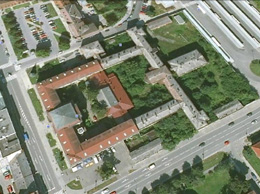
Uherské Hradiště has opened an exhibition dedicated to the history of the local prison
 |
The exhibition at the Reduta has two parts. The first is dedicated to the history of the prison. Visitors will see a number of documents and photographs. "There is, for example, an interesting comparison of testimonies from former members of the State Security about how investigations were conducted in the early 1950s, contrasted with the memories of political prisoners," said historian Pavel Portl from the Slovácké Museum and author of the exhibition to ČTK. Its second part is mainly focused on the stories of political prisoners from the 1950s.
"The space is limited; at least some stories are presented, including those of Mrs. (Anna) Honová, Vladimír Drábek, Miroslav Pištěk, Jan Haluz and others," described Portl. The 1950s are the darkest period in the history of the Uherské Hradiště prison. "It is associated with the interrogation methods of State Security officers from the 1950s, which were indeed very cruel and harsh. The most well-known case is the use of the so-called induction device, kind of electric boots," the historian added.
The exhibition is also supplemented by a video documentary, which was made in the autumn of last year directly in the prison. "Thanks to it, visitors will see the current state of the prison, which they usually cannot access. The footage is accompanied by memories of former political prisoners, recorded thanks to research by the non-profit organization Post Bellum and the Slovácké Museum," Portl added. The exhibition at the Reduta is expected to be in place until the mentioned museum of totalitarian regimes is established. According to Portl, it will, however, alternate with short-term exhibitions from the Culture Club.
The museum of totality will utilize spaces in the former prison across three floors, totaling about 2000 square meters. These include parts of the building where the chapel, solitary confinement cells, and adjacent corridors with rooms are located. There will be two permanent exhibitions in the building: the Museum of Totalitarian Regimes dedicated to the history of the prison and the Iron Curtain depicting communist propaganda.
The agreement on the extent of space for the Museum of Totality was approved by the city, Zlín Region, Ministry of Culture, and the district court. Last year's memorandum on cooperation regarding the future use of the prison was also signed by the ministries of finance and justice and the Office for State Representation in Property Affairs (ÚZSVM). At the end of last year, the court approved the transfer of the former prison complex to the ÚZSVM.
It should now be determined which state bodies will be located in the prison. The museum will occupy a smaller part of it, estimated to be a quarter of the space. The court counts it as its future seat, as it stores cases there. Other institutions of the state may also be located here. The prison was built at the end of the 19th century and served its purpose until 1960. After that, the building housed offices and storage, and it was left empty and deteriorated.
The English translation is powered by AI tool. Switch to Czech to view the original text source.
0 comments
add comment
Related articles
0
18.11.2021 | In the prison in U. Hradiště, construction surveys have been completed, and its reconstruction is being prepared
0
11.08.2021 | The upcoming exhibition will remind of the history of the prison in Uherské Hradiště
2
03.12.2020 | The Prime Minister refused to disclose the schedule for the repairs of the prison in U. Hradiště
0
15.07.2020 | ÚZSVM continues its work on the transformation of the prison into the Museum of Totality
0
08.12.2017 | The study recommended a museum and a court for the former prison in Uh. Hradiště
0
07.09.2016 | Memorandum on the restoration of the Hradec prison has not yet been signed by the court
0
29.06.2016 | The Zlín Region will participate in the renovation of the prison in Uherské Hradiště
0
11.05.2010 | The representatives of Uherské Hradiště will again discuss the transfer of the prison












